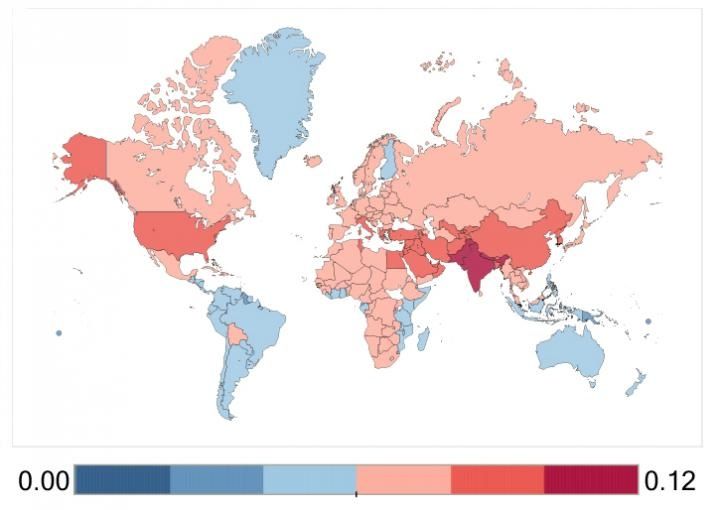
Polluted Air Sends Up to 33 Million People to the ER Each Year

Earlier this week, President Trump posted a false tweet that boasted about the U.S. having the “cleanest air in the world – BY FAR!”
But a new study has found that millions of people around the world—including U.S. citizens—are going to the ER for asthma attacks because they are breathing dirty air.
Between 9 to 33 million visits to the emergency room for asthma worldwide may be triggered by breathing in air polluted by ozone or fine particulate matter, a first-of-its-kind global study from George Washington University has found.
Fraction of total national asthma emergency room visits that are attributable to ozone.Susan C. Anenberg/GW Milken Institute School of Public Health
Ozone pollution is created when emissions from industrial facilities, electric utilities, motor vehicle exhaust and other sources interacts with sunlight. Fine particulate matter—or extremely tiny particles of pollution often associated with industrial emissions—can lodge deep into the lungs. These two forms of air pollution that are linked to asthma as well as a vast array of negative health impacts.
In the study, published Wednesday in the journal Environmental Health Perspectives, the researchers examined emergency room visits for asthma in 54 countries and Hong Kong and then combined that information with pollution levels around the globe.
Here are some of the key findings:
- Nine to 23 million annual asthma emergency room visits globally (8 to 20 percent of total global asthma ER visits) may be triggered by ozone.
- Five to 10 million asthma emergency room visits every year (4 to 9 percent of total global asthma ER visits) were linked to fine particulate matter.
- About half of the asthma emergency room visits attributed to dirty air were estimated to occur in South and East Asian countries, notably India and China.
- Although the air in the U.S. is relatively clean compared to South and East Asian countries, ozone and particulate matter were estimated to contribute 8 to 21 percent and 3 to 11 percent of asthma ER visits in the U.S., respectively.
“We know that air pollution is the leading environmental health risk factor globally,” Susan Anenberg, lead author and associate professor at the university’s Milken Institute School of Public Health, said in a press release. “Our results show that the range of global public health impacts from breathing dirty air are even more far reaching—and include millions of asthma attacks every year.”
Based on the findings, the researchers suggested that policies aimed at cleaning up the air can reduce the global burden of asthma and improve respiratory health around the world.
For instance, targeting emissions from cars—especially in big cities—would be a quick way to reduce air pollution.
“The good news is that traffic is a major source of both forms of pollution, so just reducing traffic by improving public transit and developing infrastructure that encourages people to walk or bike can improve both at the same time,” Anenberg told Environmental Health News.
5 Ways Trump Is 'Gaslighting' Us on U.S. Air Pollution Levels #TrumpWatch #TrumpTweets #CleanAir #TuesdayThoughts #WeWillNeverBeTheSame @lakotalaw @youthvgov
Heard about the latest false tweet? No. We are NOT the nation with the cleanest air. https://t.co/Gg5DEBRDTc
— EcoWatch (@EcoWatch) October 23, 2018

 233k
233k  41k
41k  Subscribe
Subscribe 
